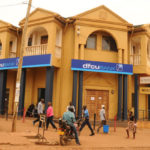DFCU Bank was one of the first banks to release results for the year ending December 31, 2021 showing that its profits had shrunk by a significant 45.7% to Shs13.2 billion from Shs24.3 billion in 2020, sending shockwaves amongst its major shareholders.
The bank also reported Shs313 billion decline in customer deposits as they reduced from Shs2, 595.3 billion in 2020 to Shs2, 282.2 billion in 2021. “When customers deposits, reduce, it means many of them are running form the bank,” this should be investigate,” said a banker in Kampala.
The bank’s loans dropped by 15% from Shs1,775.3 billion to Shs1,508.4 billion, affecting. The value of total assets. Lending in any commercial bank, analysts say, comprises about 50% of the total assets, with the banker who preferred to remain anonymous saying that it is bad business when a bank fails to give out loans or reduce.
Remember that DFCU which took over Crane Bank assets in January 2015 reported impressive figures during half of that year. Now just after five year, the financial institution reports that its total assets reduced by 10.2% from Shs3, 539.4 billion to Shs3,177.6 billion. What could be the problem with the managers at the bank?
The banker continued that dfcu relied so much on the assets of Crane Bank, acquired cheaply, and failed to grow them. “You equate that to scenario when you are given free things, you hardly work on your own,” he said.
Even though total income had increased by 8.5% from Shs415.3 billion to Shs450.6 billion, dfcu’S expenditures grew faster than income by 15% from Shs382.7 billion in 2020 to Shs440.1 billion. For the bank that has been in business for a long time, these figures are worrying.
The matter gone worse as Dfcu’s Non-Performing Loans went up 191% from Shs94 billion in 2020 to Shs274.1 billions is baffling because Bank of Uganda claimed handed over Crane Bank’s assets to Dfcu on grounds that it was well organised businesswise.
One would if Dfcu is not trying to hide the assets it inherited from Crane Bank, after all they almost got Crane Bank by paying nothing. Remember Bank of Uganda asked for Shs200 billion from dfcu, paid in installments, yet the central bank claimed it had injected Shs478 billion in Crane Bank.
In October 2016 when BoU took over Crane Bank, it was the fifth largest bank by assets which were Shs1.72 trillion; fourth largest by lending about Shs842.4 billion; sixth largest by customer deposits of Shs1.13 trillion and seventh most profitable bank with Shs45.4 billion.
After taking over Crane Bank, dfcu’s total assets would grow significantly by 76.4% to Shs3.03 trillion, making dfcu the second-largest bank by assets after Stanbic Bank, which at the time had Shs5.4 trillion in assets. There was debate in the country among economists that indeed BoU closed Crane Bank without carefully analysing the challenges it faced at the time, notwithstanding the fact that BoU had prior taking over Crane Bank praised it as being financially sound and economically important to the country.
Upon taking over Crane Bank, dfcu’S Customer deposits also grew overnight to Shs1.99 trillion, again making the bank the second largest bank in deposits from the sixth position a year before. Dfcu also found itself the third largest lender with a Shs1.33 trillion loan book after inheriting loans of Crane Bank, its (dfcu) skyrocketing to about Shs128 billion from Shs45 billion in 2016. The latest figures now show Crane Bank was a profitable business that gave dfcu a lifeline, that seems to be going away.
Customer numbers grew to more than 900,000, beating industry leader Stanbic with more than 665,000 customers (2016) but lower than Centenary Bank’s 1.48 million (2016). Dfcu also grew its countrywide coverage to a branch network of 67 and over 100 ATMs (2016: 43 branches, 42 ATMs). Majority of the branches were later vacated by dfcu after court ruled they belonged to another company but not Crane Bank. It was shocking to dfcu who had been asked to pay rent for the period they had occupied the branches.
Research and brokerage house, Crested Capital, said then that dfcu’s operating margins greatly improved across the board. Return on average assets increased 66.80% to 4.45% from 2.67% in 2016, return on average equity rose by 40.17% to 27.34% compared to 19.50% in 2016 year. Dfcu’s cost to income also improved to 49.10% from 55.98% in 2016. Thanks to Crane Bank, which was a gift from BoU as it was offered and negotiations done on phone spearheded by then executive director for supervision Justine Bagyenda.
Dfcu had become a power in Uganda’s banking industry that has over 20 commercial banks and other financial institutions supervised by BoU.
Auditor General finds irregularities in closure of Crane Bank and others
But the Auditor General Stephen Muwanga after being asked to investigate the3 closure of seven commercial banks at different times, discovered that indeed BoU offcials did not follow guidelines and processes put in place to shut banks. COSASE led by MP Abdu Katuntu in 2019 discovered that indeed Crane Bank was illegally closed by BoU.
Meanwhile Dfcu which had been gifted Crane Bank was rushing into finding someone who could manage the acquired assets well as its former CEO Juma Kisaame was going away, having disappointed some of the dfcu shareholders in regard to Crane Bank purchase
The Mathias Katamba effect
Kisaame was replaced by Mathias Katamba from Housing Finance Bank (HFB), effective December 2018. His arrival has not done the bank good. Figures do not lie as the bank continues to decline in performace.
Since the arrival of Katamba, most of the senior executives have left, thus leaving Katamba with new people that he can not rely on.
Kate Kabaingi Kiiza the Chief Finance Officer and William Sekabembe the Executive Director remain at the bank still remain at the bank. But remember Sekabembe wanted to replace Kisaame but he was ignored. The working relationship between Katamba and Sekabembe, according to an analyst cannot be all that good, thus making the working environment not conducive. The reason the bank is not doing well, despite being seen as a topnotch bank.
As such by end of 2020, dfcu had lost its second-largest bank by assets position as it recaptured its fifth position it held in 2016. It was also no longer the second largest lender, settling for the third position. On the deposits front, it also ceded its second position to Centenary Bank, dropping two more positions into the fourth place. At the end of 2020 dfcu was also no longer the second most profitable bank and dropped out of the 5 most profitable banks to the seventh position, with Shs24 billion profits compared to the Shs127 billion post-Crane Bank takeover profit of 2017.
It asset performance for the the last five years has been minimal, from Shs3,030.6 billion in 2017, down by 4.7% to Shs2,888.3 billion in 2018; rising by 2.9% to Shs2,972 billion in 2019; again, rising by 19.1% to Shs3,539.4 billion in 2020, before slumping by 10.2% to Shs3,177.6 billion in 2021.
Further, overall, in these 5 years, Compounded Annual Growth Rate in assets has been a mere 1%. Yes, a mere 1%.
Big shareholders, according to insider sources, are waiting for the Annual General Meeting (AGM) to see how to revamp the struggling bank. Some top executives are likely to leave after the AGM.
Dfcu’s scandalous acquisition of Crane Bank put BoU in bad light to the extent that sections of the public began to question the integrity of the top managers. Former deputy governor Dr Louise Kasekende and Bagyenda left unceremoniously.
The sale of Crane Bank was a curse to both BoU and dfcu more so that it brought about court cases that the majority owner of Crane Bank Sudhir Rupareria won.






